The prolific German animation studio has made 28 animated films during the 1990s and early 2000s and obviously they’ve managed to make their own unique style. In this post I’ll try to describe it.
First of all, Dingo pictures is known for virtuoso combination of watercolour backgrounds and 2D computer animation of the characters (at least in one case you can spot a paint cursor copied along with the sprite, nice Easter egg!), the only exceptions I can name are Balto where they used computer animation for waves in the background and Bremen Musicians and The Sword of Camelot where they’ve inserted live narrator (in appropriate costumes) but I’ll talk about it in the post dedicated to every Dingo Pictures cartoon (I’ve managed to get all but two of them on DVDs, another one I’ve watched on BaidUTube and hopefully can still buy but for the last one, Little Witch Arisha, I can only rely on the trailor and description provided at their site).
Second, they value the work of their artists and reuse it as much as possible. The same backgrounds appear in various pieces, like the same shopping street can be seen in Lucy and Lionel, …Even More Dalmatians and Anastasia or the same cottage appears in Anastasia and Teddy The Little Bear. And this background is so famous that it doesn’t need an introduction:

The same can be said about the fascinating tunes composed by Ludwig Ickert. After watching three of four Dingo Pictures cartoons you’ll recognize them immediately.
Third, they have quite canonical portrayal of their characters, here are few examples:
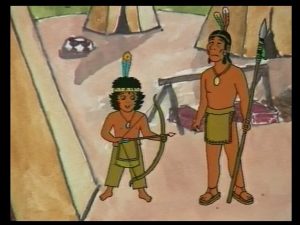 Indian kid from Pocahontas
Indian kid from Pocahontas
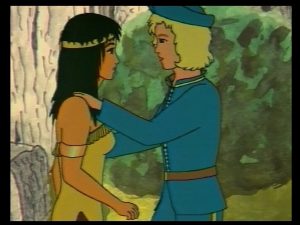 Pocahontas and not-exactly-captain Smith
Pocahontas and not-exactly-captain Smith
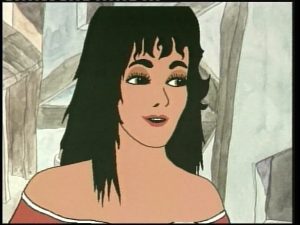 Esmeralda from The Ringer of Notre Dame
Esmeralda from The Ringer of Notre Dame
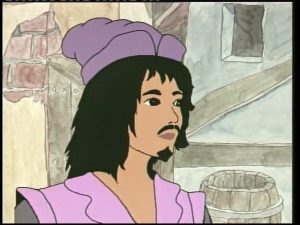 Pierre from The Ringer of Notre Dame
Pierre from The Ringer of Notre Dame
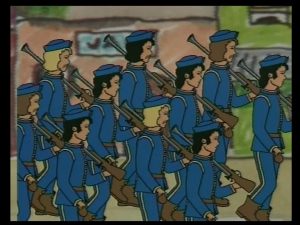
Clone troopers Soldiers from Pocahontas
As I said in my previous post, Dingo Pictures followed the steps of Osamu Tezuka and created a cast of characters that appear in almost every their feature (sometimes using different dresses and wigs): there’s Wabuu and stupid animals (the bear and dogs change their colour, the others usually don’t change anything), Generic Kid (featured above, mostly known as Aladdin or junior Aaron, brother of Moses from Prince of Egypt), Generic Young Adult (Pocahontas/Smith, Esmeralda/Pierre, Hercules, Anastasia, Jane from Tarzan Jungle King and many more), Generic Thick and Thin Duo, Cookie (the cook and lute player, sometimes doing both in the same film), Generic Old Lady and many more.
Fourth, they try to follow the strict canons in every picture: they try to even pacing by inserting some ambient scene after or inside a dialogue (i.e. the scene switches from talking persons to some unrelated action, usually involving animals) and they have their own style in depicting reactions—bobbing heads for laughs and zooming in and out heads for being shocked or scared. Another canonical thing is not using margins of the scene in full (you can spot it on the left edge of the shot with soldiers above). Usually it’s left margin that does not have animation (or even a bit of other background) but it can be right or top margin as well. And of course walking—it’s done by flipping between two-four frames of the character sprite in the middle of the picture while moving background behind them.
Fifth, they allow their heroes to have a day in the limelight: the bear is not used in scene transitions, he has minor roles in King of the Animals part 2(aka Son of the Lion King) and Teddy, the Little Bear and plays very important role in Goldie (along with the title character who’s usually seen just running around or sniffing a mushroom in other cartoons). Small birds are either cast as scene filler or as narrators (plus small roles in Pocahontas and King of the Animals), the red cat is the main hero of Puss in Boots and Charlie in Lucy and Lionel(aka Nice Cats—the main hero there plays Wabuu’s girlfriend in Pocahontas) etc etc.
And last but not least the story is quite often has an unexpected twist. Who knew about Wabuu playing a significant role in relations between Indians and Europeans; or that Moses and Aaron had a pet crocodile Beniamin (who actually saved Moses); or that Puss in Boots tricked out a wizard and not an ogre; or that puppies in animal shelter had to work by gluing labels to tins; or small details in most of their cartoons that cater to more adult audience (like a little pig visiting a slaughterhouse in Janis or mouse floozy in Mouse Police). Really, Dingo Pictures has created a fascinating world and you should watch their works on the first occasion, especially after hacking some code like libswscale.
P.S. And here’s a bonus: talking plants!
 The Elder Bush from Pocahontas
The Elder Bush from Pocahontas

(little witch Arischa and the talking tree—taken from the trailor)
P.P.S. And here’s probably the only product placement I’ve seen in Dingo Pictures works (beside some shops having real world names):
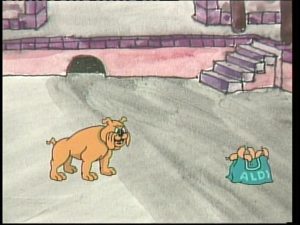 I hope that chain of UK supermarkets has paid them a lot for this promotion
I hope that chain of UK supermarkets has paid them a lot for this promotion
 European kid from Pocahontas
European kid from Pocahontas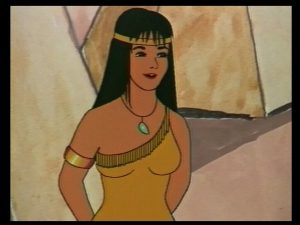 Pocahontas
Pocahontas Not-exactly-captain Smith
Not-exactly-captain Smith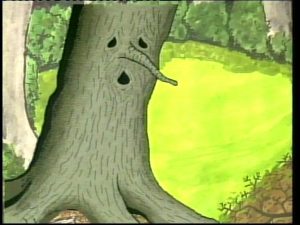 Talking tree from Goldie
Talking tree from Goldie